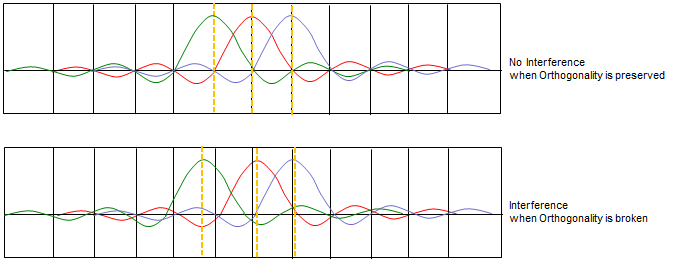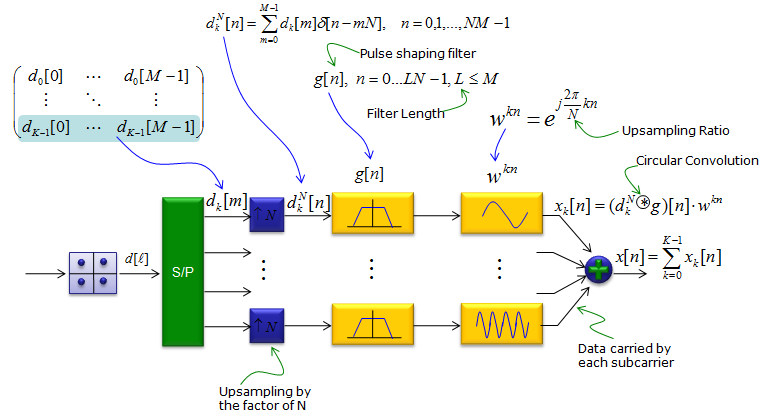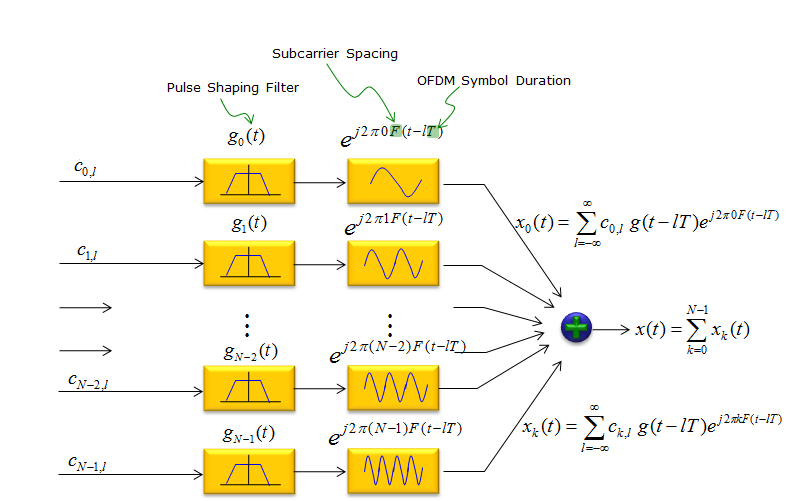|
|
||
|
For every new generations of wireless technology, we have been adopted a new physical waveforms or new modulation scheme at least. New waveform in a new generation has been designed to overcome some restriction in previous technology or increase the spectrum efficiency. It is highly likely that this holds true for 5G, implying that we will see new waveform or new modulation scheme. What kind of new waveform will be used in 5G ? The answer is not determined as of now, but it is likely that the new waveform will overcome a restriction (or problems) of the current 4G waveform (OFDM) and possibly improve spectral efficiency as well. Before we look into the new waveform, let's see what kind of problem we have with the current OFDM waveform. As you know, the current OFDM symbol is made up of sub carriers that looks as follows. The first obvious problem of this subcarrier is that it has pretty big side lobes as shown below. This is a kind of leakage of spectrum (energy loss) and this leakage can act as source of interference to neighbouring subcarriers.
To reduce the effect of interference of a sub carrier on neighbouring sub carrier, it is strictly required that the space between the sub carrier be strictly determined in such a way that each sub carrier is orthogonal to each other. As long as the orthogonality maintained as shown below, we can minimize the interference between sub carriers at least at the sampling point as shown in the upper track of the following graph. But life does not always go as we want. There are many cases where the sub carrier spacing drifts and orthogonality get broken. In that case, these subcarrier would see interference as shown in the lower track of the following graph.
Is there any way to solve (at least improve) the problems described above ? There has been several different techniques that would reduce these problem. Even though each of these techniques are different from each other in terms of details, the basic idea is similar. The basic idea is to use sub carrier shaped as shown below. As you see here, you see no (or negligible) amount of sidelobe.
With this sub carrier waveform, the problem of interference among sub carrier will be greatly reduced even when the orthogonality between sub carriers are not maintained as shown below and also spectrum leakage will greatly be redueced as well.
Now the questions is how to convert the current waveform (shown on left) into the new form (shown on right).
There are several different technologies proposed, but the most common concept is to design a specific filter and perform filtering to each sub carrier or a group of sub carriers (sub-band) as illustrated below.
Depending on what kind of filters to be used and how they will be applied (applied to each sub carriers ? or applied to a group of sub carriers) and some other factors, several different technologies are proposed. The main purpose of this page is to introduce the overal concept of these technology. However, it will take pretty long time for me to complete this page and you can search some technical papers on your own if you are really interested in this area. GFDM (Generalized Frequency Division Multiplexing)Following is from GFDM Interference Cancellation for Flexible Cognitive Radio PHY Design ([1]) In this scheme, a filter called Pulse Shaping Filter is applied per each sub carrier and multiple symbols per sub carrier are processed in a single step.
FBMC(Filter-bank based multi-carrier)In this scheme, a filter is applied per sub carrier.
UFMC(Universal Filtered Multi-Carrier)No contents yet. BFDM(Biorthogonal Frequency Division Multiplexing)No contents yet.
Reference[1] GFDM Interference Cancellation for Flexible Cognitive Radio PHY Design R. Datta, N. Michailow, M. Lentmaier and G. Fettweis Vodafone Chair Mobile Communications Systems, Dresden University of Technology, 01069 Dresden, Germany Email:[rohit.datta, nicola.michailow, michael.lentmaier, fettweis]@ifn.et.tu-dresden.de [2] 5G NOW. D3.1 5G Waveform Candidate Selection
[3] Waveform Contenders for 5G - suitability for short packet and low latency transmissions. Frank Schaich, Thorsten Wild, Yegian Chen Alcatel-Lucent AG Bell Labs Stuttgart, Germany
[4] FBMC Physical Layer : a Primer PHYDYAS
|
||







